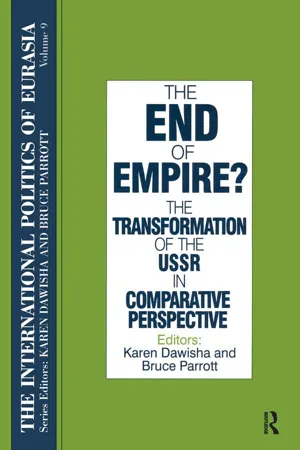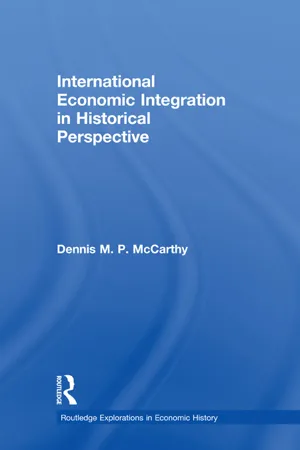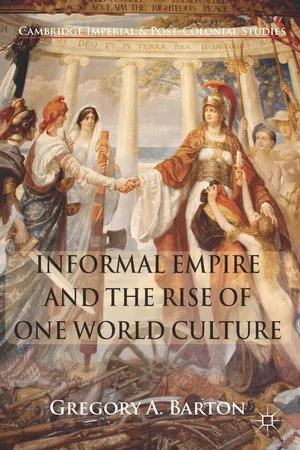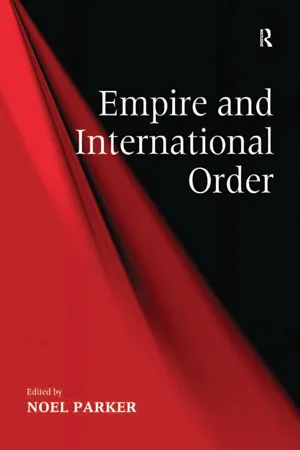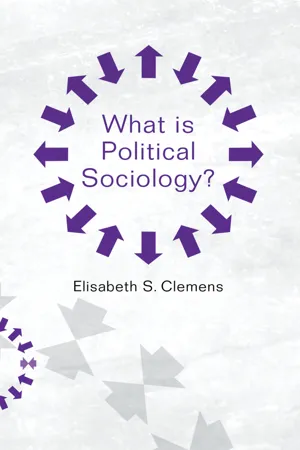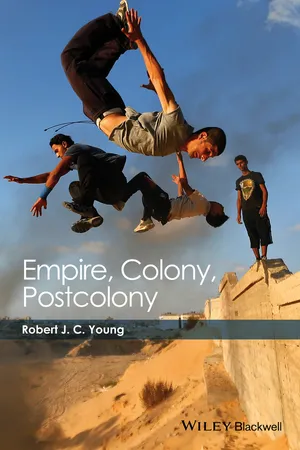History
Informal Empires
Informal empires refer to a form of influence and control exerted by a powerful nation over a weaker one without direct territorial conquest. This can be achieved through economic dominance, cultural influence, or political pressure. Informal empires often involve unequal power dynamics and can lead to exploitation and dependency for the subordinate nation.
Written by Perlego with AI-assistance
Related key terms
Related key terms
1 of 4
Related key terms
1 of 3
9 Key excerpts on "Informal Empires"
- eBook - ePub
- William Outhwaite, Stephen Turner, William Outhwaite, Stephen Turner(Authors)
- 2017(Publication Date)
- SAGE Publications Ltd(Publisher)
Lieven differentiates between formal and Informal Empires. The former consists of territories that have been conquered with military force and officially incorporated into a political structure ruled from the center. Informal Empires do not have colonies. Instead, legally independent territories are controlled by another polity through economic, cultural, and geopolitical means.Informal empire, however, usually requires greater resources than direct rule. There is no native tax-base on which to draw. There is competition on an equal basis with other countries as regards economic aid, military assistance, trade concessions and forms of cultural “imperialism” … former colonial subjects are no longer constrained by political power in their choice of outside assistance or goods. (Lieven, 2000, p. 367)Of course, in the real world, empires can be a combination of formal colonies and territories in which the metropole exerts indirect control. Both the British and US empires of the nineteenth century combined formal and informal control. When the US today is described as an empire, that term refers only to informal control since the US has no formal colonies.Informal control is above all based on economic relations. Some ancient empires (such as Egypt or Rome, discussed below) combined military- and trade-based domination, but the limited productivity of ancient societies meant that informal forms of control quickly dissolved in the absence of at least the credible threat of military power. Thus Europe became highly decentralized after the fall of the Roman Empire when the dissolution of the Roman army was quickly followed by the demise of Roman trade networks and the decline of most formerly Roman territories into autarkic economies.Capitalism, as Immanuel Wallerstein teaches us,offer[s] an alternative and more lucrative source of surplus appropriation (at least more lucrative over a long run). An empire is a mechanism for collecting tribute … In a capitalist world economy, political energy is used to secure monopoly rights (or as near to it as can be achieved). The state becomes less the central economic enterprise than the means of assuring certain terms of trade in other economic transactions. (1974, p. 16) - S. Frederick Starr, Karen Dawisha(Authors)
- 2016(Publication Date)
- Routledge(Publisher)
20Informal empire is the second salient intermediate form. Informal empire differs from its more formal counterpart only in the breadth of the residual rights of control transferred from the subordinate to the dominant state. In formal empire, the imperial state’s control of residual rights in the subordinate partner is nearly total, whereas in informal empire, the control is substantial but less than complete. This definition differs from tradition, in which the distinction between formal and informal empire rests on the mechanism rather than on the degree of control, with informal empire defined as indirect rule by local proxy.21 Although the process of control is important and easily conflated with outcome, the key distinguishing factor is the extent of the residual rights that remain in the domain of the subordinate member. The most striking modern example of an informal empire was the Soviet bloc that was established in Eastern Europe following World War II.22“Pure” conditions of anarchy or hierarchy seldom exist. Even in primarily consultative relations between allies, some degree of control may be exercised over residual choices. Similarly, in empire, local officials are often given some independence in responding to local conditions. Thus, conceived in this way, we can begin identifying degrees of hierarchy along the continuum of relations. As examples, we can note that Russia’s post–World War II relations with the states of Eastern Europe were less hierarchic than its current relations with the constituent republics of the former Soviet Union. Among the successor states today, some (the Baltics) have opted for noncooperation; some are emerging as protectorates, a relationship in which Russia continues to control their foreign policies; and others—the CIS notwithstanding—are being reintegrated into an informal Russian empire.23- Dennis Patrick McCarthy(Author)
- 2006(Publication Date)
- Routledge(Publisher)
Administrative empires need not be associated only with governments. Religious and criminal empires are creations of people not in government. But they exhibit the essential characteristic of empire building: a core group wants to extend its power and influence over other people and places. These empires develop their own organizations that cross international borders and, in this sense, they are administrative empires.Empires need not be administrative or even formally organized. In this regard the notions of informal imperialism, economic imperialism, economic colony, and sphere of influence are all important. Formal imperialism is usually associated with governments creating their own bureaucracies to administer their individual colonies. Informal imperialism designates a spread of power and influence that does not take shape in official or government organization. Informal imperialism can prepare the way for formal imperialism by setting in motion a dynamic that will compel a government to extend its administrative apparatus outside its national borders. But a crucial point is that informal imperialism does not inevitably produce formal imperialism. Whether or not that transformation occurs depends on the particular techniques employed by those engaged in a specific case of informal imperialism.Governments or private groups can pursue economic imperialism. This kind of imperialism is based on trying to dominate or manipulate international trading and investment flows. It may be informal imperialism, if it is practiced by a government but does not yet involve the official structures of that government in an up-front manner. Economic imperialists, whether they are countries, businesses, or people, strive to create conditions that will yield them more wealth. Their main concern is selfacquisition, not the betterment of their trading or investment partners. Economic imperialism has frequently been self-aggrandizement at the expense of others: the imperialist gains by inflicting losses on others.Sometimes this behavior is so concerted and widespread that it creates an economic colony. Formal colonies, those established by imperial governments, can be economic colonies, but an economic colony does not necessarily become a formal one. An economic colony is a territory or group that has become dependent on outsiders, usually but not exclusively the dominating economic imperialists. Dependent means excessively reliant on those outsiders for the sources of one’s own survival and wellbeing. This excessive reliance entrenches a crucial harm: the loss of local decision-making about one’s economic present and future.- G. Barton(Author)
- 2014(Publication Date)
- Palgrave Macmillan(Publisher)
2 The Idea of Informal EmpireThe idea of informal empire is largely about the rationalization of the world and the responses that rationalization has produced. As this chapter illustrates, scholars, politicians, public intellectuals and others have handled with dexterity the idea of informal empire while never using the term or, in many cases, while utilizing a variety of terms or phrases to describe the same concept. It seemed inevitably bound up with the process of the European concept of the rule of law, the development of science, Enlightenment ideals and industrial and professional modernization. Applying these revolutions to human society outside of Europe, and establishing elite formations that reflected these developments, were integral to the process of building an imperial network.Theories of imperialismA classic treatment on empire, Imperialism: A Study (1902) by John A. Hobson, contains many of the key ideas that later scholars discuss concerning informal empire.1 While Hobson did not elaborate a theory of informal empire or of financial imperialism outside of formal empire, many scholars have taken his critique of aggressive state-sponsored imperialism and applied it broadly to other areas of the world. Hobson believed that money lay at the heart of imperialism. Imperialism represented a mosaic of forces – the mission to civilize, promote good government, spread Christianity, exterminate slavery, elevate the lower races. Nevertheless the desire for financial gain motivated the business class to venture outside national boundaries in search of a higher rate of return than could be found at home. At the centre of this investment class lay hidden a ganglion of commercial tentacles. These were the:parasites upon patriotism . . . men of a single and peculiar race, who have behind them many centuries of financial experience, they are in a unique position to manipulate the policy of nations . . . Does any one seriously suppose that a great war could be undertaken by any European state, or a state loan subscribed, if the house of Rothschild and its connections set their face against it?2- eBook - ePub
- Noel Parker(Author)
- 2016(Publication Date)
- Routledge(Publisher)
Students of imperial history have a far more sophisticated conceptual framework than that. During the imperial age, for example, British colonial administrators such as Frederick Lugard clearly understood the distinction between “direct” and “indirect” rule; large parts of the British Empire in Asia and Africa were ruled indirectly, through the agency of local potentates rather than British governors. A further distinction was introduced by the British historians Jack Gallagher and Ronald Robinson in their seminal 1953 article on “the imperialism of free trade”, in which the authors showed how the Victorians used naval and financial power to open markets well outside their colonial ambit. There is an important and now widely accepted distinction between “formal” and “informal” empire. (Ferguson 2003, 160) In an article discussing the nature of the present international political and military pre-eminence of the United States, Elke Krahmann (2005) observes as well that the concepts unipolarity, hegemony and empire too often are used interchangeably, something which tends to confuse the scholarly debate. She suggests linking the three concepts explicitly to the three attributes ‘capabilities’, ‘influence’ and ‘policies’. Unipolarity would then refer mainly to the relative distribution of capabilities and power in the international political system, at a time when one single state holds supremacy over all others. Hegemony, moreover, would say something not only about one single state’s dominant power position, but also about this supreme power’s ability to exert influence over and govern other states. Finally, empire would presuppose both of the above – supreme capabilities and the ability to exert power – but would in addition say something about the concrete policies through which the dominant power upholds its powers (Krahmann 2005, 533) - eBook - ePub
An Unproclaimed Empire: The Grand Duchy of Lithuania
From the Viewpoint of Comparative Historical Sociology of Empires
- Zenonas Norkus(Author)
- 2017(Publication Date)
- Routledge(Publisher)
Third are “vulture empires”. They emerge on the borders or the peripheries of failing empires, when the subordinates, clients or ally-satellites of a failing empire take over all or part of its territory. The failed empire’s cultural legacy plus its administrative structure is also usually adopted. As an example, Barfield mentions Ancient Egypt when it was ruled by dynasties originating from Nubia, and several episodes in China’s history when dynasties of non-Chinese origins restored the empire’s unity. The most important of these was the last (Qing) dynasty (1644–1912), whose power base was Manchuria, a region that the Chinese had hitherto ruled indirectly.Fourth are “empires of nostalgia”, based on the memory of already failed empires, which appropriate their traditions and symbols, yet do not possess any attributes typical of a “real” empire. Barfield gives as examples the Carolingian Empire, which had no permanent capital, transport or communication networks, and political formations in Ethiopia whose dynasts laid claim to the “imperial” title even in those periods of the country’s history when Ethiopian statehood was on the verge of extinction.Notes
1 It would not have been right to offer a final version at the beginning, before the concepts used in the definition were discussed in detail. So only the discussion of Taagepera’s works allowed highlighting difficulties related to the concept of an empire’s size and the “minimalist” definitions of empire in general.2 This author defines an empire as follows: “an empire is a large, multi-ethnic territorial state with a complex power structure” (Turchin 2006: 3).3 “A type is defined as fully polythetic, if no characteristics are possessed by every case in the type” (Bailey 1994: 27–28).4 - eBook - ePub
Shadow Empires
An Alternative Imperial History
- Thomas J. Barfield(Author)
- 2023(Publication Date)
- Princeton University Press(Publisher)
Introduction
EMPIRES AND THEIR SHADOWSEMPIR ES WERE THEWORLD’S largest and most durable polities. They dominated Eurasia and North Africa for more than two and a half millennia, only losing the last vestiges of that long hegemony in the early twentieth century. They appeared independently in a variety of cultural contexts worldwide and developed their own distinct imperial traditions. While the success of empires is often attributed to their military might, it is their ability to organize diversity that better explains their long duration and seemingly perpetual reinvention. More than any other type of polity, an empire was of a size and complexity that required tools of governance that set it above and beyond its component parts. Smaller and more parochial city-states and kingdoms, by contrast, maintained narrowly defined boundaries of exclusion between themselves and others that put limits on their size and administrative capacity. Empires too would have insider/outsider distinctions, but at an entirely different scale and flexibility of measurement. The former was like a local family-run business, the latter like a multinational corporation—your neighborhood coffeeshop versus Starbucks. And while empires might take the name of a founding people or dynastic line, they invariably transcended them.Empires also left cultural and political templates that survived their demise. Successor states deliberately copied many of them, sometimes claiming to be their heirs. The use of the term civilization is often implicitly grounded in sets of high-culture attributes that these empires laid down as distinct and dominant templates in different parts of the world. They were Janus-faced entities simultaneously celebrated for their achievements and condemned for the violence they inflicted on others to sustain themselves. A Victorian-era Great Britain that put down bloody rebellions against its own colonial rule in India and South Africa could simultaneously celebrate Boudica’s equally bloody failed rebellion against imperial Rome in the first century A.D. and eventually erect a statue of her in a fighting chariot outside Parliament in London. In France, Jacques-Louis David’s neoclassical painting The Distribution of the Eagle Standards celebrated Napoleon’s 1804 reintroduction of Roman legionary eagles to inspire his Grande Armé e in a style that would have also undoubtedly won praise from Emperor Nero (figure 1.1 ). Both Russia’s Vladimir Putin and China’s Xi Jinping appear to long for the glories of empires that the respective revolutions in their countries earlier condemned to the ashcans of history. On the other hand, France’s 1960 comic book resister of Rome, Asterix, proved so popular that his exploits were translated into forty different languages and French readers ranked Asterix the Gaul itself as number twenty-three in a list of the one hundred best books of the twentieth century in a 1999 Le Monde survey.1 - No longer available |Learn more
- Elisabeth S. Clemens(Author)
- 2016(Publication Date)
- Polity(Publisher)
Both nation-states and empires figure prominently in the development of the contemporary political world. A subset of states, the European powers, extended their reach around the globe through a succession of empires: Portuguese, Spanish, Dutch, British, French, and German. Both Russia and China expanded territorially across Asia in processes of imperial expansion followed by more or less complete incorporation in national configurations. Centered in Istanbul, the Ottoman Empire at its peak encompassed large portions of both Europe and Asia. The Americas were colonized and subdivided by multiple imperial powers – Portuguese, Spanish, French, British and, along a sliver of the Pacific Coast, Russian. The coastlines of Africa were dotted by strongholds of trading empires and, in the nineteenth century, the interior of the continent – or at least its maps – was reorganized by a competitive rush of imperial powers to claim colonial rights over territory. Japan followed a similar model, extending its control through parts of the Western Pacific while, by the late nineteenth century, an ascendant United States would build its own empire in the Pacific and the Caribbean. In all their different forms, these political systems were based on imperialism as a system of indirect rule, “a strategy of political control over foreign lands that does not necessarily involve conquest, occupation, and durable rule by outside invaders” (Steinmetz 2014: 79).These patterns of conquest and settlement set in train further conflicts and transformations. In North America, conflicts over the “rights” of colonists as Englishmen fueled what would become the first revolution for national independence, quickly followed by the Haitian Revolution (1791–1895) which undercut France's key foothold in the slave economies of the Caribbean and its forward base in terms of expansion into the Americas. Over the course of the nineteenth century, other Portuguese and Spanish colonies in Latin America made successful claims for their independence, declaring themselves to be republics. In each of these cases, the claims for autonomy as a state were linked to claims of membership in a nation, a people entitled to self-government. Empires continued to generate conflicts for national independence around the globe, culminating in a wave of decolonization in the years between the end of the Second World War and 1960 that produced a planet organized in the increasingly standardized form of the nation-state (Meyer et al. 1997; Strang 1992). - eBook - ePub
- Robert J. C. Young(Author)
- 2015(Publication Date)
- Wiley-Blackwell(Publisher)
5 Colonialism and ImperialismWe have seen that from the earliest days colonies, settlements, or trading posts abroad were established for a number of reasons: freedom of religion, need for land for surplus population, or desire to accumulate wealth through trade or the establishment of plantations. They tended to be created, as a result, on a relatively haphazard, pragmatic basis, driven by the needs of individuals, small groups, or licensed trading companies. Though they became components of particular empires, colonies were not generally planned from the outset as part of an imperial project, and there was often a degree of power struggle between a local desire for autonomy and control by the Crown to which they retained their nominal allegiance, as in the case of Britain’s or Spain’s American colonies.Later colonies, especially in the nineteenth century, tended to be established as part of an imperial design. Empire involves universal rule by a sovereign power from the imperial center. Unless the empire is organized through indirect rule as separate fiefdoms, in some degree this requires a bureaucracy of sorts, loyal to the emperor, that will drive its priorities and require its laws to be obeyed throughout the empire. The rationale of empire is regional or global power, internal and external, and, as part of this, the accumulation of wealth. Nineteenth- or twentieth-century European empires did not essentially differ from this model. The word that came to be given to the imperial project as an idea driven from the metropolitan center at the highest level of the state itself was “imperialism.” Imperialism was an overarching concept or ideology that openly advocated and practiced domination over the territories of other peoples of a different race. While colonization was the practice of actual settlement or occupation, the term “colonialism” is used to describe the colonial system that was put into operation in the colony itself, whereby non-Europeans, considered “backward” on racial grounds, were ruled and exploited by European (or Russian or Japanese) rulers or settlers. Colonies were the separate parts of empire, empire was the totality, the complete picture, seen as the product and possession of the imperial state and from its centered perspective. By the late nineteenth century, imperialism also came to be used to describe the development or maintenance of power (“hegemony”) of one country over another through economic, diplomatic, and cultural domination even in the absence of direct colonial occupation.
Index pages curate the most relevant extracts from our library of academic textbooks. They’ve been created using an in-house natural language model (NLM), each adding context and meaning to key research topics.
Explore more topic indexes
Explore more topic indexes
1 of 6
Explore more topic indexes
1 of 4

